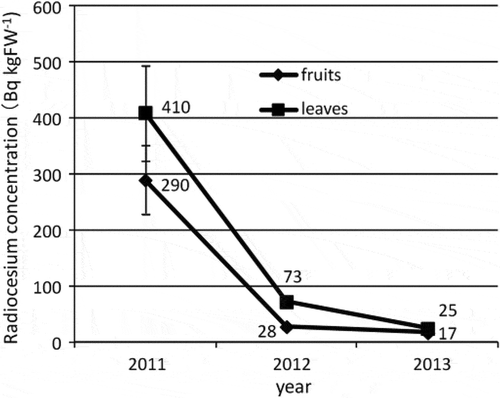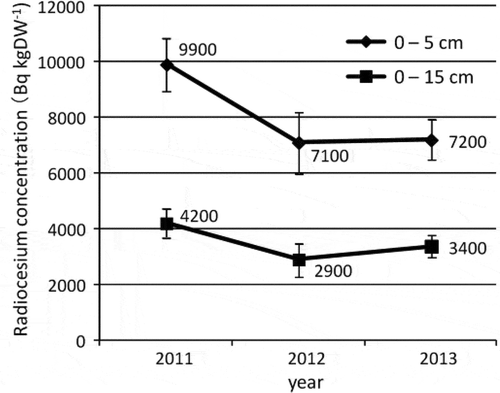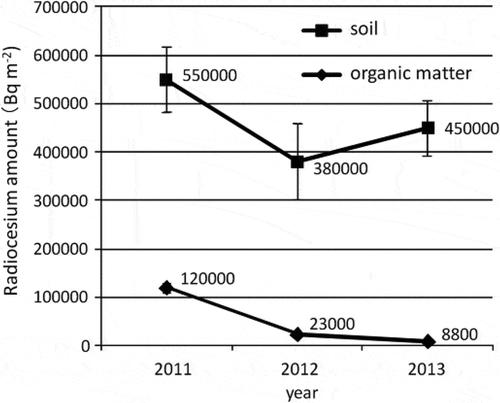Abstract
We investigated changes in the radiocesium concentration in a blueberry (Vaccinium virgatum Aiton) orchard in Fukushima prefecture to clarify the radiocesium contamination for 3 years after the Tokyo Electric Power Company’s Fukushima Daiichi nuclear power plant accident occurred in mid-March 2011. In the aboveground part of blueberry bushes, the concentrations of radiocesium in branches that were directly affected by radioactive fallout were the highest among the samples investigated, and the concentrations in fruits were the lowest. The concentration of radiocesium decreased exponentially in the fruits and leaves over 3 years. The radiocesium concentrations in soils were higher in the surface layer. The amount of radiocesium in organic matter on the soil surface under the canopy greatly decreased from 2011 to 2012. The transfer factor of the radiocesium from soil to blueberry fruits decreased annually. These results suggest that radiocesium adhered directly to the aboveground organs of blueberry bushes in March 2011, and it is possible that the accumulation of radiocesium in fruits is mainly due to radiocesium transfer from the branches and trunk to fruits for several years after the nuclear power plant accident.
INTRODUCTION
After the Tokyo Electric Power Company’s Fukushima Daiichi nuclear power plant (FDNPP) accident in mid-March 2011, radionuclides were widely distributed, falling onto a large area. Fruit orchards were contaminated, mainly by radiocesium from the accident. At the time of the accident, many kinds of deciduous fruit tree had not yet sprouted, including blueberries (Vaccinium spp.). Therefore, diffused radiocesium fell onto the branches and soil surface in these orchards. After the FDNPP accident, Sato et al. (Citation2013) reported that the radiocesium in new organs of deciduous fruit trees contaminated during the dormant period might have been transferred mainly from the tree bark and branches.
Blueberries are shallow-rooted plants (Retamales and Hancock Citation2012a) that grow better in low-pH soil (Retamales and Hancock Citation2012b). Arapis et al. (Citation1997) reported that the vertical migration rate of 137Cs in soil ranged from 0.39 to 1.16 cm year−1, and the main part of the residual radiocesium was located in the upper 10 cm of soil using podzolic soils (sandy, sandy–loam), podzolic–gley soils, gley soils and peaty soils in open field conditions, even 7 years after the Chernobyl accident. So, it is likely that shallow-rooted blueberry bushes may easily uptake radiocesium from undisturbed soil. After the accident in 2011, blueberry fruits showed radiocesium concentrations in excess of the official tolerance, which was 500 Bq kg fresh weight (FW)−1 until April 1, 2012 (when it was changed to 100 Bq kg FW−1) in the orchards. To reduce the radiocesium concentration in blueberry fruits, the actual situation of the contamination in blueberry orchards should be clarified.
Here, we report on changes over 3 years in the radiocesium contamination in blueberry (Vaccinium virgatum Aiton) bushes and their orchard resulting from the FDNPP accident. We have also investigated radiocesium concentrations in a Japanese chestnut (Castanea crenata Sieold & Zucc.) orchard (Kusaba et al. accepted), and here we discuss differences between the radiocesium concentrations in blueberry bushes and Japanese chestnut trees.
MATERIALS AND METHODS
Plant and soil samples
Samples from rabbit-eye blueberry (Vaccinium virgatum Aiton) bushes, soils and organic matter on the soil surface under the canopy were collected in an experimental field of the Fruit Tree Research Center, Fukushima Agricultural Technology Center (Fukushima city, Japan). The soil type of the field is a fine-textured Brown Forest soil (Cambisol), and the soil surface was managed by sod culture with weeds. Three rabbit-eye blueberry bushes (unknown cultivar) that were at least 20 years old were investigated in this study. All samples were collected at the optimum harvesting time of fruits in August. All samples were obtained from all three bushes except fruits and leaves in 2013. In 2013, fruits were sampled from only one bush and leaves from only two bushes in 2013. Leaf samples were collected from the mid-part of the current shoot. Current shoots (2011–2012), 2-year-old branches (2011–2012), and 3-year-old branches (2012) were collected as branch samples. Soil samples were collected from four points under the canopy at sites approximately 50 cm from the trunk and at depths of 0–5 cm and 0–15 cm with a core sampler (ϕ = 3.5 cm). The bulk density of the soil was 880 kg m−3.
Sample preparation
Blueberry fruits were washed with tap water, wiped with paper towels and then minced after measuring the fresh weights. Branch samples were cut into lengths of about 1 cm, measured for FW, and then dried at 70°C to a constant weight. Leaf samples were weighed and dried at 70°C to a constant weight before mincing.
Stones (> 2 cm) and coarse organic matter were removed from the soil. Part of the soil sample was dried at 110°C to a constant weight to calculate the water content of samples.
The organic matter, including fallen leaves, dead branches and aboveground parts of weeds, was collected from a 20 cm × 20 cm area on the soil surface under the canopy and directly submitted to a germanium semiconductor detector.
Radioactivity measurement of radiocesium
The radiocesium concentration was measured by gamma-ray spectrometry with a high purity germanium detector. The radiocesium concentrations were calculated in Bq kg FW−1 for bush samples, and in Bq kg dry weight (DW)−1 for soil samples. To estimate the amount of radiocesium amount per m2 of the soil, the radiocesium concentration in the soil at 0–15 cm depth and the soil bulk density were used, assuming that the radiocesium did not migrate below the top 15 cm of the soil. The radiocesium concentrations were corrected for physical decay to the date of sample collection and were expressed as the sum of cesium-134 (134Cs) and cesium-137 (137Cs).
RESULTS AND DISCUSSION
Radiocesium concentrations in some blueberry organs
The radiocesium concentrations were obtained from three trees as replications. We investigated the difference in radiocesium concentration in some parts of the blueberry bushes (). In the samples investigated, organs on which fallout-derived radiocesium might be directly adhered were a 2-year-old branch in 2011 and a 3-year-old branch in 2012. In both years, the radiocesium concentrations in these branches were the highest among the samples investigated. The concentration in the fruits was the lowest among all samples, and the concentration decreased by 90% from 2011 to 2012. In apricot (Prunus armeniaca L.) trees (Antonopoulos-Domis and Clouvas Citation1990) and peach (Prunus persica (L.) Batsch) trees (Takata Citation2013), the highest concentration of radiocesium was detected in branches on which fallout-derived radiocesium might be directly adhered. This trend was the same as in blueberry bushes in this report. The trends in the changes of radiocesium concentrations in current shoots in 2011 and 2-year-old branches in 2012 (these were the same organs) were different between blueberries and chestnuts. The radiocesium concentrations in the 2-year-old branches of blueberry bushes in 2012 were almost the same as those in the current shoots in 2011, whereas those in the 2-year-old branches of chestnut trees in 2012 decreased in comparison with those in the current shoots in 2011 (Kusaba et al. accepted). Additionally, in blueberry bushes, the radiocesium concentrations in the 3-year-old branches in 2012 decreased in comparison with those in the 2-year-old branches in 2011 (these were the same organs). These results might be attributed to radiocesium transfer from the 3-year-old branches, which showed the highest concentration of radiocesium among the organs in 2012, to 2-year-old branches. The mechanism underlying this observation, however, remains unclear.
Table 1 Radiocesium concentrations (134Cs + 137Cs Bq kg FW−1) in each organ of blueberries (Vaccinium virgatum Aiton)
Changes in radiocesium concentration in fruits and leaves
The changes in radiocesium concentration over 3 years in fruits and leaves are shown in . The concentration of radiocesium decreased exponentially for 3 years in each of the blueberry organs investigated. The rate of the concentration decrease was faster than the natural decay of radiocesium. Although the initial concentration was different, the trend of the concentration decrease was similar in each organ. Exponential decreases of radiocesium were also reported in fruits of apricots, sweet cherries (Prunus avium (L.) L.), pears (Pyrus communis L.), and apples (Malus pumila Mill.) by Antonopoulos-Domis et al. (Citation1991). The trend of the concentration decrease in blueberry bushes was almost the same as in these fruit trees.
Figure 1 Changes in radiocesium concentrations (134Cs + 137Cs) in fruits and leaves of blueberries (Vaccinium virgatum Aiton). Values are means of samples collected from three bushes in 2011 and 2012. Values in 2013 were obtained from one fruit sample and two leaf samples from three bushes, respectively. Bars indicate standard error of the mean.

Changes in radiocesium concentration in the soil
The changes in radiocesium concentration over 3 years in soils under the canopy are shown in . Radiocesium concentrations in the surface soil (0–5 cm) were higher than those in the total soil (0–15 cm). In undisturbed fruit tree orchards, over 90% of the radiocesium was found within the top 6 cm of soil in Fukushima after the accident (Sato Citation2014). The radiocesium concentration in the surface soil of the blueberry orchard in this study might have been higher than that in the soil at 0–15 cm because the orchard was also undisturbed after the accident. The concentrations in soils decreased from 2011 to 2012, but did not decrease from 2012 to 2013. The rate of the decrease in radiocesium concentration in the soil was slower than that in fruits.
Changes in the radiocesium amount in the soil and organic matter on the soil surface
The changes in the amount of radiocesium in the soil and organic matter on the soil under the canopy are shown in . The amount of radiocesium in the soil per m2 was estimated by assuming that the radiocesium did not migrate below the top 15 cm of the soil. The amount of radiocesium in the soil decreased with year, and the decrease might be attributed to the physical decay of 134Cs. The amount of radiocesium in organic matter greatly decreased from 2011 to 2012. The high amount of radiocesium in 2011 could be due to the direct adhesion of radiocesium that fell onto the organic matter. In August 2011, 5 months after the nuclear power accident, approximately 18% of the radiocesium (out of the total in the soil and organic matter) was observed in organic matter, and this rate decreased to 5.7% in August 2012 and 1.9% in August 2013.
Accumulation of radiocesium in blueberry bushes
In peach trees, Takata (Citation2013) suggested that the radiocesium falling on the bark might be translocated inward through the lenticels and migrate to the fruits after the FDNPP accident. Sato (Citation2014) reported that over 95% of the radiocesium was in the aboveground part, and only a few percent underground in apple, peach, and persimmon (Diospyros kaki Thunb.) trees. From these findings and the results in this report, the high concentration detected in the organs of blueberries that were directly affected by fallout could be due to the direct adhesion of radiocesium from the fallout. Furthermore, Takata et al. (Citation2012) reported that 2.2% of the radiocesium contained in the total peach tree was translocated to new organs, and 0.8% of the radiocesium to fruits, suggesting that the accumulated radiocesium in peach trees could be difficult to translocate to new organs the year after the accident. If this is also the case in blueberry bushes, the rapid decrease in the radiocesium concentration of fruits in 2012 compared to 2011 might be attributable to the difficulty of translocation of radiocesium.
In the blueberry root system, about 50% of the root dry mass was found in the top 23 cm (Retamales and Hancock Citation2012a). Despite this root system, the rate of decrease of the soil radiocesium concentration was slower than that of fruits or leaves. Antonopoulos-Domis et al. (Citation1991) demonstrated that the root uptake of radiocesium provided a small fraction of the total contamination of leaves and fruits of trees planted before the Chernobyl accident. In addition, the transfer factor (TF) calculated as [radiocesium concentration of nut (Bq kg FW−1)/radiocesium concentration of soil (Bq kg DW−1)] decreased annually, suggesting that the radiocesium TF value in this study might have been affected by the direct contamination of the aboveground parts of blueberry bushes. Therefore, the contribution of the root uptake of radiocesium to the radiocesium accumulation in blueberry fruits might be small for 3 years after the accident. Together with these results, the accumulation of radiocesium in blueberry bushes might have been caused mainly by the direct adhesion of radiocesium onto the plant. Moreover, the accumulation of radiocesium in fruits might be mainly due to radiocesium translocation from branches to fruits for several years after the nuclear power plant accident.
On the other hand, it is well known that blueberries prefer a low soil pH for their growth (Retamales and Hancock Citation2012b). Radiocesium is more easily absorbed by plants with decreasing soil pH (Maraziotis Citation1992), so the analysis of the soil pH-dependent uptake of soil radiocesium by blueberries remains to be solved.
ACKNOWLEDGMENTS
We thank Dr. Kunihisa Morinaga, Yuriko Kano-Murakami and Hideo Bessho (NARO Institute of Fruit Tree Science) for their technical assistance. This work was supported by the research project “Development of Radioactive Materials Removal Technologies for Agricultural Soils” (2011) in Strategic Funds for the Promotion of Science & Technology conducted by the Ministry of Education, Culture, Sports, Science and Technology of Japan, and by the research projects “Development of Radioactive Materials Removal and Reduction Technology for Forests and Farmland” (2012), and “Development of Decontamination Technologies for Radioactive Substances in Agricultural Land” (2013) conducted by the Ministry of Agriculture, Forestry and Fisheries of Japan.
REFERENCES
- Antonopoulos-Domis M, Clouvas A 1990: Compartment model for long-term contamination prediction in deciduous fruit trees after a nuclear accident. Health Phys., 58, 737–741. doi:10.1097/00004032-199006000-00005
- Antonopoulos-Domis M, Clouvas A, Gagianas A 1991: Radiocesium dynamics in fruit trees following the Chernobyl accident. Health Phys., 61, 837–842. doi:10.1097/00004032-199112000-00015
- Arapis G, Petrayev E, Shagalova E, Zhukova O, Sokolik G, Ivanova T 1997: Effective migration velocity of 137Cs and 90Sr as a function of the type of soils in Belarus. J. Environ. Radioact., 34, 171–185. doi:10.1016/0265-931X(96)00013-6
- Kusaba S, Matsuoka K, Saito T, Kihou N, Hiraoka K accepted: Changes in radiocesium concentration in a Japanese chestnut (Castanea crenata Sieold & Zucc.) orchard following radioactive fallout. Soil Sci. Plant Nut. doi:10.1080/00380768.2014.975104
- Maraziotis E A 1992: Soil-to-plant concentration factor and dependence on soil parameters. J. Radiol. Prot., 12, 77–84. doi:10.1088/0952-4746/12/2/003
- Retamales JB, Hancock JF 2012a: Growth and Development. In: Hulbert S (ed) Blueberries, pp. 51–74. CAB International, Wallingford, UK.
- Retamales JB, Hancock JF 2012b: Nutrition. In: Hulbert S (ed) Blueberries, pp. 103–142. CAB International, Wallingford, UK.
- Sato M 2014: Investigation of the radiocaesium migration pathway into the deciduous fruit tree contamination at the dominant period and trials to decrease the radiocaesium uptake via bark. Japan. Soil Sci. Plant Nut., 85, 103–106 (in Japanese).
- Sato M, Takata D, Abe K, Ohno T, Takase T, Kawatsu K, Tanoi K, Muramatsu Y 2013: Investigation of the radiocesium migration pathway into the deciduous fruit tree contaminated at the dormant period. Hort. Res. (Japan), 12 (Supp. 1), 78 (in Japanese).
- Takata D 2013: Distribution of radiocesium from the radioactive fallout in fruit trees. In: Nakanishi Tm and Tanoi K Agricultural Implications of the Fukushima Nuclear Accident, pp. 143–162. Springer, UK.
- Takata D, Sato M, Abe K, Tanoi N, Kobayashi N, Yasunaga E, Sasaki H, Nakanishi N, Oshita S 2012: Remobilization of radiocaesium derived from Fukushima nuclear power plant accident in the following year in ‘Akatsuki’ peach trees. Hort. Res. (Japan), 11 (Sup. 2), 353 (in Japanese).


